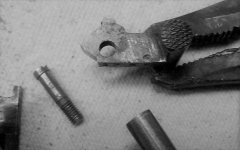Howdy, been away for a while but I knew this would be the place to get an answer. My question is in general regarding the design of the top latch. I've become interested in the small pocket pistols of the late 19th and early 20th century. Most of these are break top designs and most of the latches are of the inline design which I consider a very poor design since the latch itself must take the thrust of firing. I've always thought a much better design had a mortise in the extended top strap to close over a raised stud on the standing breech so that the latch need only hold it down. That makes a lock up as strong as a solid frame. Examples would be the Scofield and the Webley revolvers. Some few American top breaks also employed this design. I see that the S&W Safety Hammerless had a similar latch at one time but by far the most employed the common weak inline latch. I'm wondering which models employed the stronger latch setup?
I've attached a photo (if it works) of a cracked latch and bent latch screw from a cheap top break which shows the weakness of that design
I've attached a photo (if it works) of a cracked latch and bent latch screw from a cheap top break which shows the weakness of that design
Attachments
Last edited:

